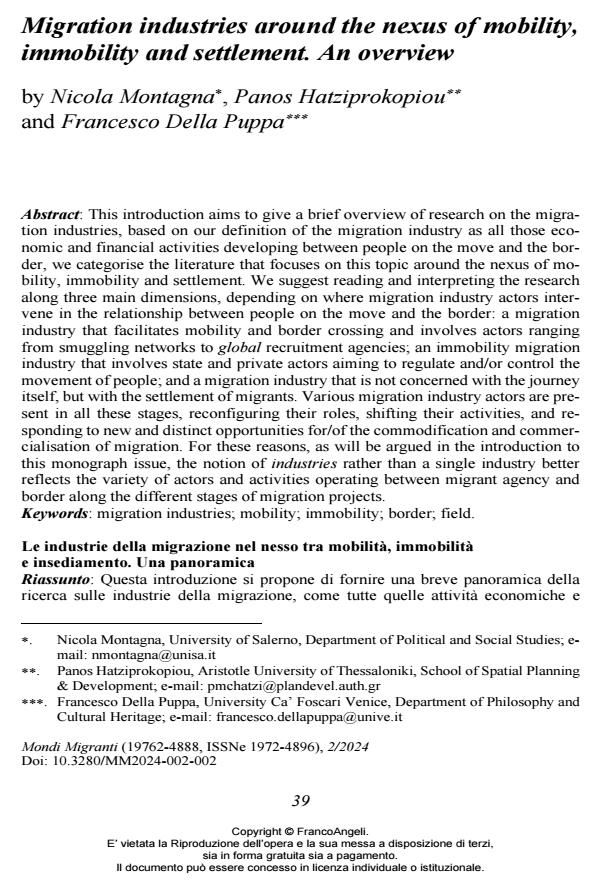Migration industries around the nexus of mobility, immobility and settlement. An overview
Titolo Rivista MONDI MIGRANTI
Autori/Curatori Nicola Montagna, Panos Hatziprokopiou, Francesco Della Puppa
Anno di pubblicazione 2024 Fascicolo 2024/2
Lingua Inglese Numero pagine 22 P. 39-60 Dimensione file 200 KB
DOI 10.3280/MM2024-002002
Il DOI è il codice a barre della proprietà intellettuale: per saperne di più
clicca qui
Qui sotto puoi vedere in anteprima la prima pagina di questo articolo.
Se questo articolo ti interessa, lo puoi acquistare (e scaricare in formato pdf) seguendo le facili indicazioni per acquistare il download credit. Acquista Download Credits per scaricare questo Articolo in formato PDF

FrancoAngeli è membro della Publishers International Linking Association, Inc (PILA)associazione indipendente e non profit per facilitare (attraverso i servizi tecnologici implementati da CrossRef.org) l’accesso degli studiosi ai contenuti digitali nelle pubblicazioni professionali e scientifiche
This introduction aims to give a brief overview of research on the migration industries, based on our definition of the migration industry as all those eco-nomic and financial activities developing between people on the move and the border, we categorise the literature that focuses on this topic around the nexus of mobility, immobility and settlement. We suggest reading and interpreting the research along three main dimensions, depending on where migration in-dustry actors intervene in the relationship between people on the move and the border: a migration industry that facilitates mobility and border crossing and involves actors ranging from smuggling networks to global recruitment agen-cies; an immobility migration industry that involves state and private actors aiming to regulate and/or control the movement of people; and a migration in-dustry that is not concerned with the journey itself, but with the settlement of migrants. Various migration industry actors are present in all these stages, re-configuring their roles, shifting their activities, and responding to new and dis-tinct opportunities for/of the commodification and commercialisation of mi-gration. For these reasons, as will be argued in the introduction to this mono-graph issue, the notion of industries rather than a single industry better reflects the variety of actors and activities operating between migrant agency and border along the different stages of migration projects.
Questa introduzione si propone di fornire una breve panoramica della ricerca sulle industrie della migrazione, come tutte quelle attività economiche e finan-ziarie che si sviluppano tra le persone in movimento e il confine, e di classifi-care la letteratura che si concentra su questo argomento intorno al nesso tra mobilità, immobilità e insediamento. In questa introduzione proponiamo di in-terpretare la ricerca secondo tre dimensioni principali, a seconda di dove gli attori dell’industria migratoria intervengono nella relazione tra le persone in movimento e il confine: un’industria migratoria che facilita la mobilità e l’attraversamento dei confini e coinvolge attori che vanno dalle reti di con-trabbando alle agenzie di reclutamento globale; un’industria migratoria dell’immobilità che coinvolge attori statali e privati che mirano a regolare e/o controllare il movimento delle persone; e un’industria migratoria che non si occupa del viaggio in sé, ma dell'insediamento dei migranti. Diversi attori dell’industria migratoria sono presenti in tutte queste fasi, riconfigurando i lo-ro ruoli, spostando le loro attività e rispondendo a nuove e distinte opportunità di mercificazione e commercializzazione della migrazione. Per queste ragioni, riteniamo che la nozione di industrie piuttosto che di industria rifletta meglio la varietà di attori e attività che operano tra l’agency dei migranti e il confine lungo le diverse fasi dei progetti migratori.
Parole chiave:industrie migratorie; mobilità; immobilità; frontiera; campo.
- Migration Intermediation and Ethical Boundary Work: the Case of Italy’s Legal-Administrative Field Paola Bonizzoni, Fabio De Blasis, Giacomo Lampredi, in Journal of International Migration and Integration /2025 pp.1619
DOI: 10.1007/s12134-025-01251-3
Nicola Montagna, Panos Hatziprokopiou, Francesco Della Puppa, Migration industries around the nexus of mobility, immobility and settlement. An overview in "MONDI MIGRANTI" 2/2024, pp 39-60, DOI: 10.3280/MM2024-002002